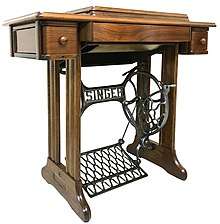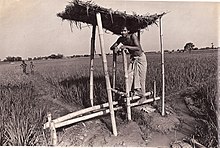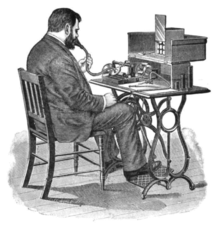Treadle
A treadle (from Old English: tredan, "to tread") is a mechanism operated with a pedal for converting reciprocating motion into rotating motion. Along with cranks, treadmills, and treadwheels, treadles allow human and animal machine power in the absence of electricity.

Before the widespread availability of electric power, treadles were widely used to power a range of machines. They may still be used as a matter of preference or in environments where electric power is not available.
Operation and uses

A treadle is operated by pressing down on its pedal with one or both feet, causing a rocking motion. This movement rocks a large crankshaft driving a flywheel.
Textiles
Treadles were once used extensively in creating textiles and clothing, powering spinning wheels, looms, and sewing machines. Elias Howe and Isaac Singer popularized their use and they became a fixture in households worldwide. Today the use of treadle textile machines is mostly relegated to hobbyists and historical re-enactors, but they remain in use in the developing world.
Industry and crafts
Treadles may be used to turn lathes for metal or wood, as in the pole lathe, or to power rotating or reciprocating saws.
Other uses

Treadle pumps are used to provide water for agricultural and domestic use in poor areas not served by water systems.
Dated uses

Treadles were used to power phonograph cylinders.
See also
| Look up treadle in Wiktionary, the free dictionary. |